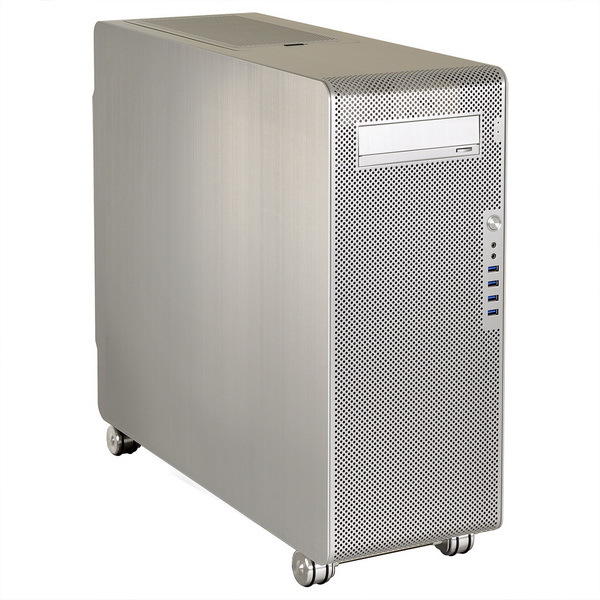Lian Li PC-V1000 computer case
Review date: 5 June 2004.Last modified
03-Dec-2011.
I reviewed Lian Li’s original PC-60 computer case
almost four years ago, now.
The PC-60 was, and is a good product. Actually, it’s rather better now
than it was then, because Lian Li have been tweaking its basic design ever
since. They rotated the bottom 3.5 inch drive cage to fit another two bays
in, they improved the front panel retainers, they added ports to the front
panel; the list goes on. They’ve also released a host of variants on the
PC-60 design — different front panels, side windows, cheaper versions with
a few features deleted, and so on.
Even Lian Li’s quite non-PC-60-ish cases — full towers, super-quiet variants,
little microATX boxes — have had a lot of PC-60 DNA in them. And other manufacturers
eager to horn in on the funky aluminium case market have made some boxes
that aren’t, when you get right down to it, exactly dissimilar to the PC-60.
There’ve been sparks of innovation here and there, but nobody ever came
up with anything really different.
Until now.
This is Lian Li’s PC-V1000. It’s completely different from the PC-60
and its multitudinous relatives.
Well, OK, not completely different. The V1000’s still mainly made
of aluminium, it still accepts regular ATX PC components, and it’s not much
bigger than a PC-60; it’s 210mm wide, the same as the PC-60, but it’s 490mm
tall and 525mm deep (50mm and 40mm more than the PC-60, respectively). That’s
about 8.3 by 19.3 by 20.7 inches.
The PC-V1000 also isn’t a whole lot more expensive than the older cases.
When the PC-60 first came out here in Australia it cost around $AU400, ex
delivery; now, Aus PC Market
will be selling V1000s for $AU374 including Sydney metropolitan delivery
(but, as is traditional for fancy aluminium cases, not including
a power supply).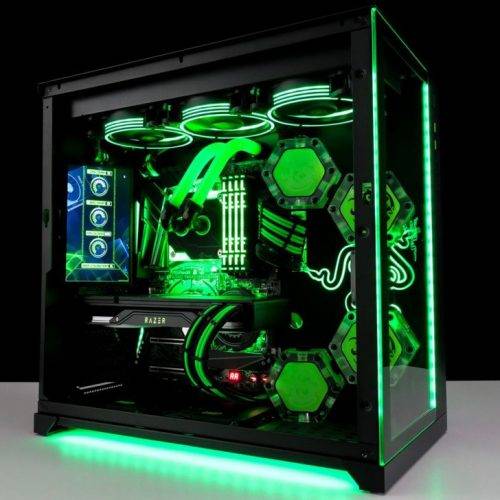
Well, they will when the shipment finally shows up. It hasn’t, as I write
this; unlike practically every other Lian Li product, the new V-series cases
have been available in the USA and Europe for rather a while, but will only
be hitting Australia in a week or two.
Aussies can pre-order a V1000 now, though, and I recommend they do. This
new Lian Li is a really, really good piece of gear.
The guided tour
The V1000’s perforated front panel gives a nod to Apple’s recent «cheese
grater» Power Macs, but that’s
as derivative as this box gets. Pretty much everything else is new, and
innovative, and interesting.
Forget, for instance, about Lian Li’s affection for realistic, but nonetheless
fake, carbon fibre end-plates on their front bezels. The V1000’s front bezel
— which isn’t detachable — curves smoothly around to meet the top and bottom
panels, and the fit and finish is excellent.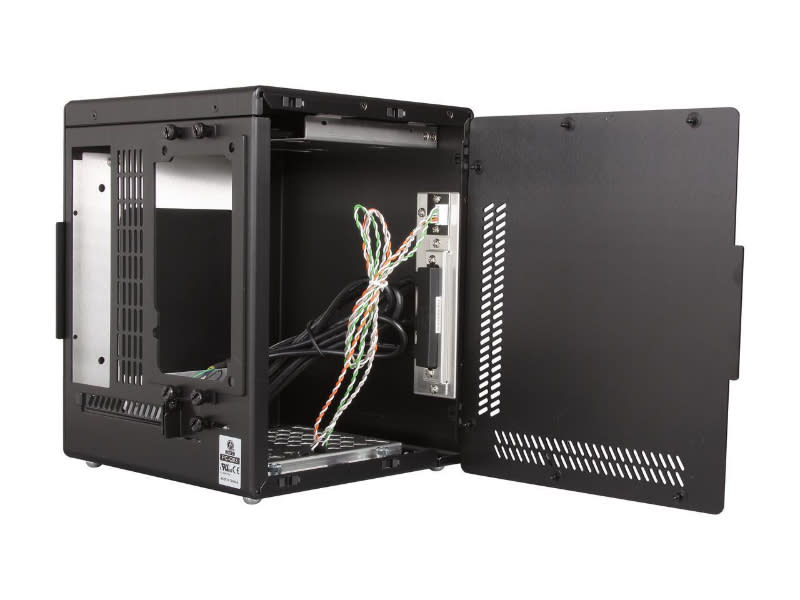 Lian Li have always made cases
Lian Li have always made cases
that look great and don’t rattle, but the V1000 takes it to a new level.
Look at the delicately scalloped edge of the side panel, for instance.
It’s as close to perfectly even as you could ask, and it’s actually got
a bit of a purpose, as well; it lets you get a better grip on the edge of
the otherwise-magnificently-featureless panel when you’re removing it.
(Lian Li, by the way,
call this a «Crenulate
edge». Amazingly enough, that actually is a
word.)
You might also notice that there are rather a lot of little holes in
the front panel. In the back and bottom panels, too, as you’ll see shortly.
All of these holes lead straight to the inside of the case; they’re not
blanked off by more panels inside. So this is a very well ventilated case.
I haven’t, in my cutting-out-the-background
Photoshoppery for this review, bothered to make every little hole as
white as the main background for each image, so the true sieve-like nature
of the PC-V1000 may not always be obvious.
But trust me — it’s cheesecloth. It’s a colander. It’s hardly there at
all. There are one zillion computer cases out there where air has to take
a circuitous path to get in, and has limited places where it can get out;
this is not one of those cases.
The PC-V1000 has a modest collection of front ports — two audio, two
USB, one FireWire — and you’ll only be able to use them if you have motherboard
headers to match. They all expect to plug into pin-connectors on a mobo,
not rear panel ports. Every halfway normal motherboard for ages now has
had USB headers, but audio and FireWire headers are less common.
If you’ve got the headers, though, you’ll definitely be able to connect
the ports, because their cables terminate in both one-piece plugs for motherboards
with the appropriate pinout, and separate single-pin plugs for motherboards
with some other arrangement.
The power button is steel, not silver plastic.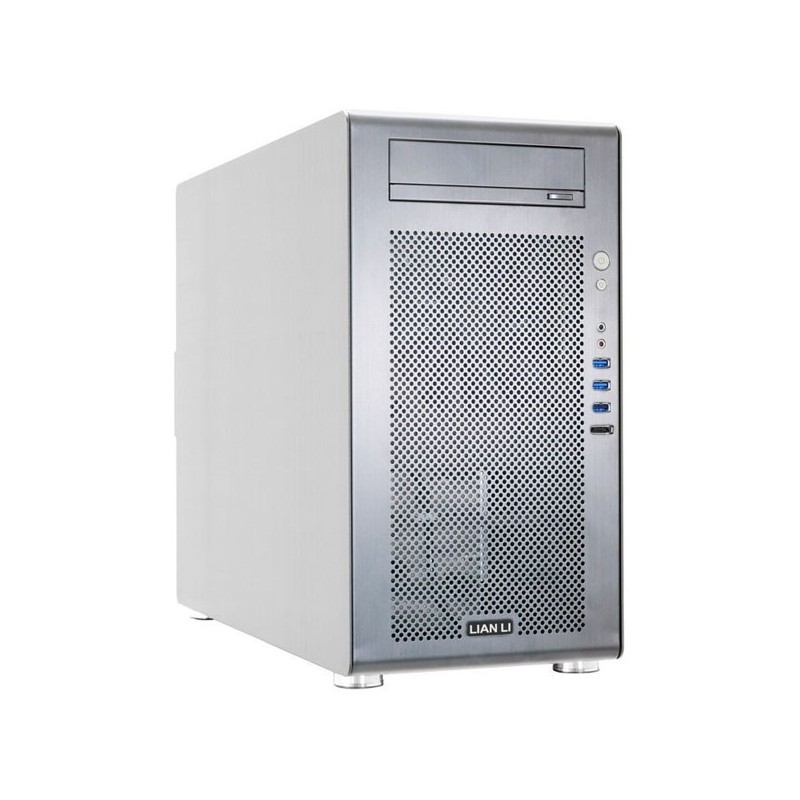 There is no reset button.
There is no reset button.
The power and drive LEDs are tiny little understated things (though they’re
still high intensity LEDs, clearly visible in anything less than direct
sunlight). And the floppy bay has an aluminium bezel, to avoid The Curse
Of Beige.
The floppy bay is set in the middle of the bottom 5.25 inch bay; you
can remove it entirely if you like and install a 5.25 inch device there
instead. Without the floppy, there are five 5.25 inch bays.
The top 5.25 inch bay has an aluminium drive-hider, as well. Both aluminium
drive fronts are, as far as I can see, the same as the C-01 and F-01 I reviewed
here.
The PC-V1000 does not have feet; it has wheels (and, as I mentioned,
more vent holes on the bottom panel). No more dragging your case forward
across the carpet when you need to get at the back panel. The wheels are
solid spun aluminium; they’re quite weighty.
Does this mean the case’ll roll around all the time? No, because.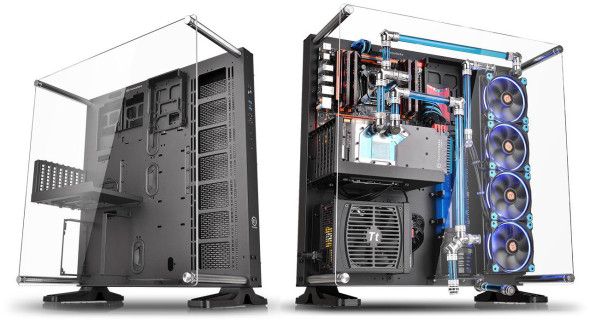 ..
..
…this sliding brake lets you immobilise the rear set of wheels at will.
I still wouldn’t be too sanguine about setting the V1000 up on the deck
of a small boat in high seas, but it’ll stay put well enough in an ordinary
computer room.
If you really don’t like the wheels then you can unscrew them, but that’s
a waste of some very slick bits of aluminium, if you ask me. Without the
wheels the case is only about 450mm (17.7 inches) high, though, so if you’ve
just discovered you can’t fit it under your desk, removing the wheels is
an option.
This is the back panel. And yes, it’s the right way up. Lian Li have
decided to flip the usual ATX case arrangement around, apparently in pursuit
of better air flow and more efficient use of the interior space. The PSU’s
at the bottom, and the motherboard slots are at the top.
The aluminium box sticking out of the back of the case is a noise reducing
air diverter for the rear exhaust fan.
You can easily unclip the diverter if you don’t want to use it. Without
it, and ignoring the thumbscrews sticking out, the V1000 is only about 490mm
(19.3 inches) deep.
Removing the diverter reveals an unexpectedly large fan grille. The PC-V1000
has only two fans, but both of them are medium-power 120mm units, instead
of the 80mm fans that most cases use. As usual for Lian Li, the fans are
made by ADDA.
Also as usual, the major removable components of the PC-V1000 are retained
with thumbscrews. There’s only one thumbscrew for each side panel, though,
up close to the top of the case.
Undo that thumbscrew and it won’t fall into your hand; it’s captive.
Pull on it when it’s undone, and a latch pops out. Now, you can just hinge
the side panel down and lift it out; you don’t have to slide it fore or
aft. Little pins sticking out from the panel locate it properly. The latch
The latch
mechanism works very well indeed.
Note, by the way, the padlock tab on this latch (and this latch only),
which makes this case as secure as every other padlock-tabbed box. Which
is to say, not very secure at all, as anyone with a chunky screwdriver can
hook it through the padlock and twist the whole tab off. It’ll probably
keep casual LAN party miscreants out while you visit the bathroom, though.
The PC-V1000 side panels are, essentially, just a flat plate of aluminium.
The metal’s not rolled around the edges, like normal Lian Li panels; there
isn’t even an indentation for use as a handle, because the latched attachment
method doesn’t require one.
A flat unfolded sheet of metal isn’t strong, so to stop the side panels
vibrating and flexing and maybe even getting dented or bent, Lian Li have
made them out of hefty 2mm thick aluminium, instead of the 1.2mm metal they
normally use.
The mounting rails add to the panel’s weight, because they’re steel.
They’re attached to the panel with screws, fastened into shallow tapped
holes in the aluminium. Like everything else in the V1000, this is a really
neat fabrication.
But it’s not a light one. Each side panel weighs about 1520 grams (3.35
pounds) by itself. A PC-60 side panel weighs only about 720 grams (1.6 pounds).
The whole V1000, however, isn’t particularly heavy by aluminium case
standards. Lian Li don’t publish a weight figure for the V1000, but if my
bathroom scales can be believed, it’s about 8 kilos without power supply.
That’s a couple of kilograms more than the old PC-60, but it’s still pretty
light.
In the great scheme of things, the weight of a case doesn’t matter that
much. Steel cases often don’t actually weigh that much more than
aluminium ones; it’s not hard to find a well-built steel midi-tower that
only weighs in at nine kilos.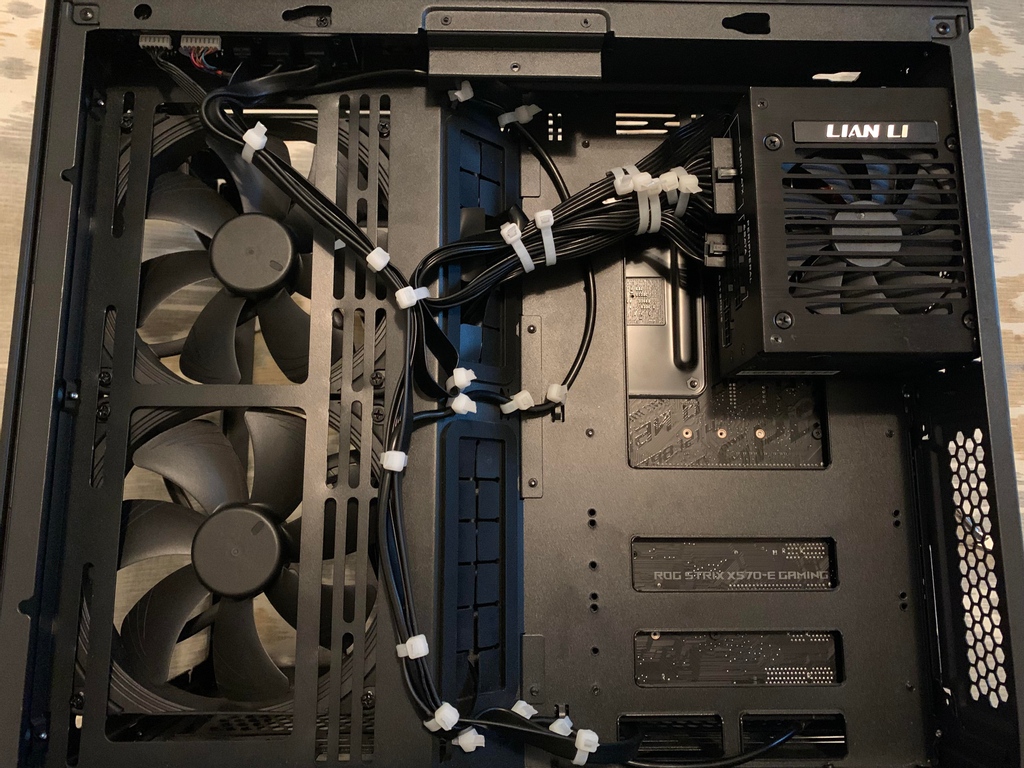 Many steel full towers only clock in at about
Many steel full towers only clock in at about
12.
This is because although aluminium is only about a third as dense as
steel, it’s not nearly as strong. The very best aluminium alloys are only
about as strong as the mild steel used in cheap PC cases, and aluminium
cases don’t use those alloys, because they’re really expensive. So to achieve
the same strength, makers of aluminium cases have to use more metal, and
they end up not saving a whole lot of weight. Especially when you take into
account the weight of the rest of the components that make up a PC.
Oh, I’m sorry — were you waiting for the shots of the inside?
There you go.
There’s weirdness inside the V1000 beyond its topsy-turvy layout. It’s
divided into two compartments, partially sealed off from each other. The
lower one is fed by the intake fan and contains the 3.5 inch bays, exhausting
some air into the rest of the case, a little into the separate PSU sub-compartment,
and some out of the bottom vents.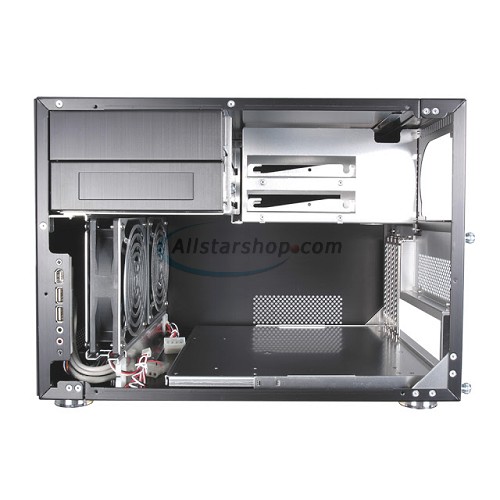
The upper, larger compartment is where the 5.25 inch bays and motherboard
tray live. Air’s sucked through this compartment by the rear exhaust fan.
There’s plenty of room for air to leak between the compartments, because
there’s a gap between the edge of the compartment divider and the side panel,
and also a decent-sized plastic-edged hole through which you’re meant to
thread your power and data cables. But this still definitely isn’t an open-plan
case.
The layout of the V1000, by the way, is likely to cause problems with
most motherboards and Parallel ATA hard drives. A standard 18 inch PATA
ribbon cable is unlikely to reach from the mobo to the 3.5 inch bays. There’s
no chance at all of it reaching if you want to plug two drives into it.
SATA cables will reach with no trouble (and be easier to route, too),
so this isn’t likely to be a big deal for people using new hardware. SATA
connectors are standard equipment on most motherboards today, and SATA drives
aren’t much more expensive than PATA ones any more.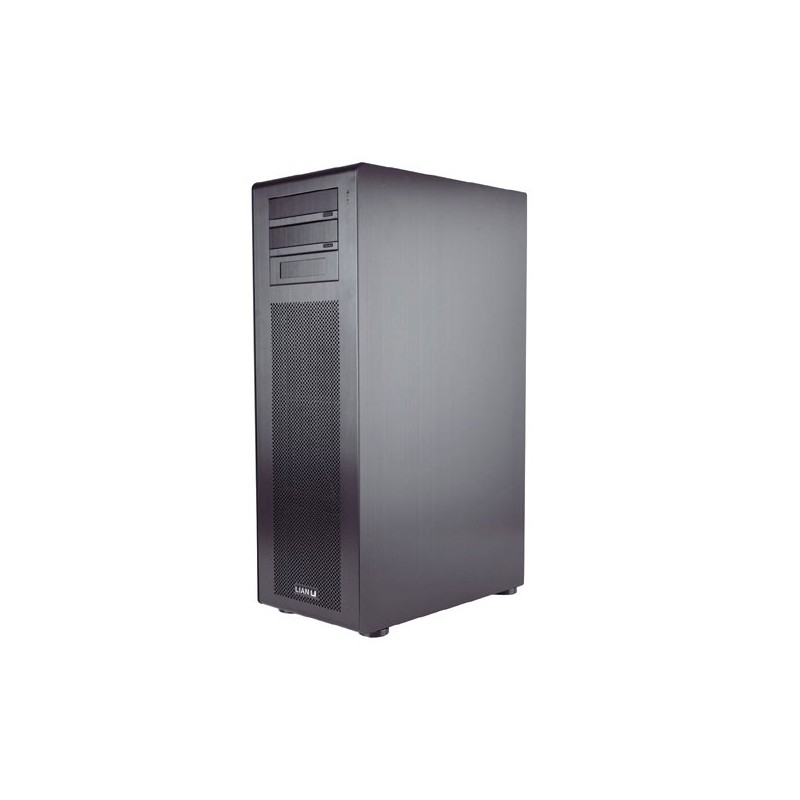
If you want to move your old PC into this new case, though, or just re-use
a PATA hard drive or two, then you’re probably going to have to use at least
a 24 inch, slightly-out-of-spec cable to do it. As I’ve
written before, over-length PATA leads do generally
work OK, but they’re not the choice of champions.
The 5.25 inch drive bays aren’t very remarkable. The only slightly odd
thing is the PC speaker, lurking there under the lowest bay.
(No, the PC speaker magnet does not pose a risk to your data,
no matter where it’s mounted.)
Here’s the floppy bay by itself. It’s retained by four screws; the drive-hider
at the top of the 5.25 inch bays is screwed in place too, but the other
blank bay panels are just click-in units, as is normal for Lian Li.
The lower bays are much weirder. There are six of them, and they’re
not removable. They don’t need to be.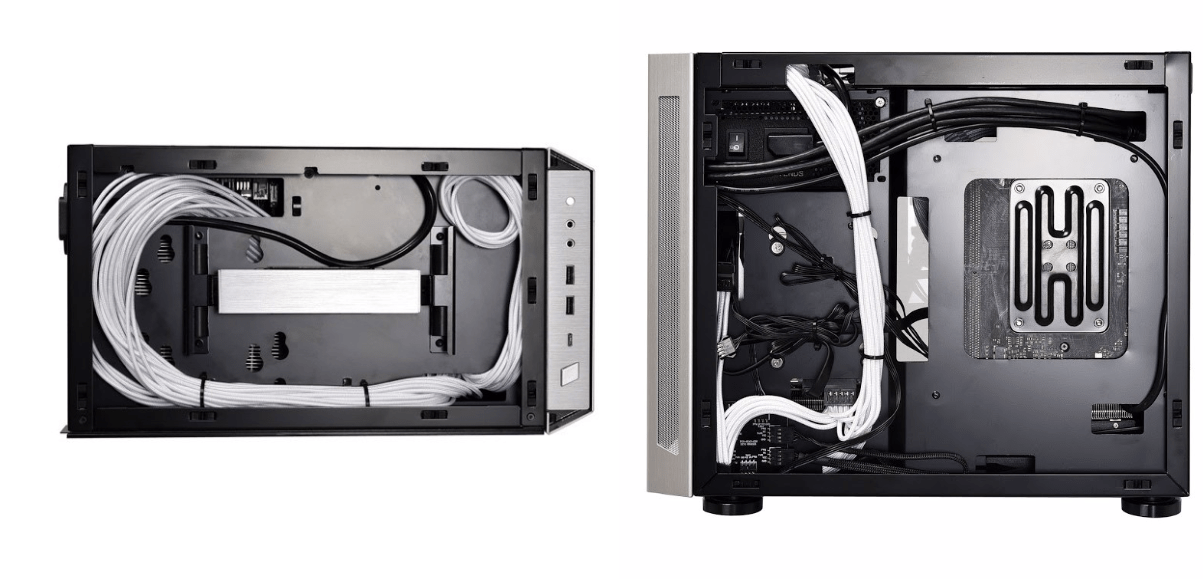 To install a drive, you thread special
To install a drive, you thread special
mounting screws into the sides of it, then just slide the drive into the
plastic rails that define a bay, and then click down a retaining latch on
either side. This is a neat, low-vibration arrangement, and the proximity
of the big front fan should deal with any drive cooling issues created by
the lack of metal-to-metal contact with the chassis.
You get 24 of the special screws with the PC-V1000, enough for all six
bays, provided you don’t lose any. If you do lose some, you should
be able to make do with ordinary flat-headed drive mounting screws of reasonable
length; you’ll just have to be careful to thread them in the right distance.
The V1000 bits box, by the way, also contains four expanding push-pins
(for mounting another fan, I think, though I don’t know where…), three
little cable ties and one self-adhesive adjustable wire clip to help you
marshal your cables, one spare thumbscrew, a collection of Lian Li’s signature
clip-in mobo mounts, and plenty of regular drive and motherboard mounting
screws.
Because the V1000’s front panel isn’t removable, you have to open the
case to get at the front fan and its dust filter. It’s retained by two more
captive thumbscrews, one on each side, so you need to remove both
sides of the case to extract it. The latching system makes that easy enough
that it’s not a big deal, but you won’t be able to tell how clogged the
filter is without taking the whole assembly out. Regular removable-front
Lian Lis make it rather easier to check the filter status.
The filter retainer is a simple clip-in arrangement; Lian Li use a similar
filter box on many of their other current cases.
Here, for your information, is the latch bar that holds the side panels
on. It doesn’t just hook into the back corner of the panel; it engages the
top mounting rail all the way across, and holds the panel firmly in place.
And yet, forsooth, it’s easy to unlatch.
There’s that big exhaust fan, and Lian Li’s usual ultra-shiny rear expansion
slot covers. As normal for Lian Li cases, the PSU mounts on a removable
plate, which lets you install it without threading the whole awkward object
through from the inside.
Unusually, though, there’s no removable motherboard mounting tray.
The info sheet that accompanied my review case shows one, but the tray in
the case itself is firmly pop riveted in place.
The V1000’s PSU sub-compartment, by the way, is sized for standard ATX
power supplies. If your PSU is deeper than about 165mm (6.5 inches), it
won’t fit. This won’t be a problem for most people, since normal PSUs tend
to be about 140mm (5.5 inches) deep. If you’ve got some monster four-fanned
LED-lit one-kilowatt uber-PSU, though, expect it to dangle out the back
of the V1000. Chunky fan grilles on the top or bottom of your PSU may also
make it difficult to install it, by fouling on the hole in the back of the
case.
Cooling and noise
Lian Li have made a bunch of midi-tower cases with three or four 80mm
fans in them, and those cases are pretty good at shifting a ton of air through
the enclosure without making a hideous racket.
The standard 80mm Lian Li fans have a 1.8 watt nominal rating (they use
lower power fans in some cases). The 120mm units
in the V1000 have a 2.88 watt nominal rating, which isn’t much for a fan
of this size.
ADDA specify (PDF datasheet
here) these
25mm thick 120mm fans to move 72 cubic feet per minute (CFM) of air, when
just hanging there in space. They’ll shift rather less than that between
them through the PC-V1000, because each fan only has a 0.095
inches of mercury (inHg)
static pressure rating. ADDA’s 38mm thick 120mm fans with the same motor
achieve 0.135 inHg.
One fan on intake and one on exhaust gives no change in the theoretical
airflow figure, but twice the static pressure capability. That’d be 72CFM
That’d be 72CFM
and 0.19 inHg for the V1000, if its fans were in a true push-pull arrangement,
but the two-compartment interior means they’re not, really.
The older Lian Lis do have a pretty straightforward push-pull
setup. Recent fan-filled Lian Lis have two fans on intake and two on exhaust,
with one exhaust fan on the back panel and one in the lid. That gives double
the airflow and double the pressure of one fan.
The old 1.8 watt, 25mm thick 80mm fans are rated at 31.4 CFM and 0.114
inHg, so the four-fan config gives 62.8 CFM and 0.228 inHg.
So if the V1000 fan setup were push-pull, it’d be quite likely to move
pretty much the same amount of air through the case as the old four-fan
config did. A bit more theoretical airflow, a bit less pressure capacity;
overall, it’s a wash.
The two-compartment setup messes up this back-of-an-envelope calculation,
but the extreme leakiness of the V1000’s multi-perforated case means the
two fans probably do move plenty of air, and probably also manage to move
most of that air past things that actually need cooling.
The super-ventilated design of the V1000 inescapably means that there’ll
be a certain amount of air short-circuiting happening — warm air exiting
the bottom and being sucked back in at the front, and cool air being sucked
in at the back and then blown straight out again. But there’s just so very
much ventilation there that I doubt this’ll matter.
On to noise.
The old 80mm fans are rated at 28.3dBA
(at one metre), while the 120mm ones score only 34.4dBA.
Decibels are a logarithmic scale, so when you double a noise figure —
by adding another identical fan, for instance — you get a result that’s
exactly 3dB higher. Two 34.4dBA fans makes 37.4dBA. Four 28.3dBA fans makes
34.3dBA.
Human hearing is roughly logarithmic, too. Good perceived loudness figures
are exceedingly difficult to work out, but in this situation 37.4dB won’t
sound a whole lot louder than 34.3dB. Anything below 40dBA qualifies as
«pretty quiet».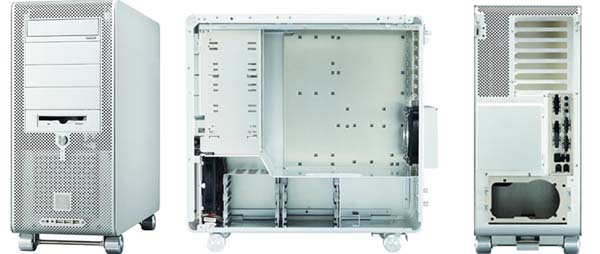
Of course, all of these facile airflow and sound level measurements only
really work in
Physics Experiment
Land, where there are no other factors to consider.
Fans blow most of their noise out the back with their air; intake fans
therefore don’t sound as loud as outlet fans. And noise levels vary with
the amount of work the fan’s doing, and with the construction of the case,
and with the way the fans are mounted.
The PC-V1000 can be expected to let more sound out than an earlier Lian
Li, because of all of those vent holes. Install a loud high-power CPU cooler
in this case and you’ll hear more from it than you would if you put it in
a PC-60. If the overall ventilation’s better, though, you won’t need
as loud a cooler.
And the PC-V1000’s fans are both mounted on rubber vibration isolators
— little rubber washers on the expanding-pin mounts of the rear fan, and
rubber pads on the sides of the bracket for the front one. This quietens
This quietens
them significantly.
Overall, the PC-V1000 is likely to work out a bit quieter than a four-fan
PC-60-series case — especially if you leave the rear deflector in place,
to fire the exhaust fan noise into the carpet.
(Anandtech, by the way, found the V1000 to only be
marginally louder
than the noise-reduced PC-6070. If I assume they
made reliable numbers, it means I won’t have to leap around with my sound
meter figuring it out for myself. So I will.)
Variants
The V1000 is not the only V-series case — though it may be the only one
a lot of people will be able to buy for a while.
The rest of the V-series lineup includes the
PC-V1200, which
is the same as the V1000 only deeper, to accommodate the seen-once-in-a-blue-moon-these-days
full length expansion cards. Then there’s the equally deep but taller full
tower PC-V2000,
the quieter PC-V1100
(with a front door, and sound damping foam inside), and the
PC-V2100, which
is the full-tower version of the 1100.
There’s also a black-anodised PC-V1000B, and I dare say there’ll be silver
and black variants of most, if not all, of the other V-series cases as well.
Overall
If someone had told me that the PC-V1000 was one of those super-exotic,
ultra-expensive Japanese PC cases for the computer aficionado with a great
deal more money than sense, I would have believed them. OK, it isn’t a pyramid,
it doesn’t have a glossy automotive-paint finish, and it doesn’t have drive
bays made from clear-coated shiny copper — but it’s definitely a step up
from every other enthusiast case I’ve seen.
As with many previous Lian Lis, this case will appeal to J. Random Overclocker,
and to people who want a really nice looking bespoke computer for their
home office, and to corporate types who want to impress visitors. It’s new
and interesting, it’s easy to work on, its fit and finish are excellent,
and all of its new features are actually useful, not just changes
for their own sake.
For $AU374 (or a bit more, for shoppers outside the Sydney metro area),
the PC-V1000 is a bargain. Highly recommended.
Review PC-V1000 kindly provided by
Lian Li.
Buy one!
Australian readers can purchase the PC-V1000 from Aus PC Market.
If you’d like to order the silver version I reviewed,
click here. If you’d like the black version,
click here.
(if you’re NOT from Australia, Aus PC Market
won’t deliver to you. If you’re in the USA, try a price search at
DealTime!)
Lian-Li’s PC-V1000 Updated After 6 Years
Skip to main content
When you purchase through links on our site, we may earn an affiliate commission. Here’s how it works.
The PC-V1000Z chassis from Lian-Li was very popular due to its outstanding build quality and extensive hardware support, but it’s old — the chassis came out out way back in 2008. With hardware advancing the way it does, a number of its features have become redundant, and it is simply missing some features found on newer cases. Now, though, Lian Li has updated the case after a six-year service life and built the PC-V1000L.
With hardware advancing the way it does, a number of its features have become redundant, and it is simply missing some features found on newer cases. Now, though, Lian Li has updated the case after a six-year service life and built the PC-V1000L.
Among the changes to a more modern enclosure, Lian-Li has done away with most of the optical drives and has added support for more water cooling, better cable management, a more flexible hard drive system, and more.
The PC-V1000L supports up to E-ATX motherboards, and it has eight expansion slots in the back, giving it support for up to four dual-slot graphics cards. The case also supports CPU coolers up to 170 mm tall and graphics cards up to 380 mm long, with hard drive trays installed.
Removing specific hard drive trays will give you space for graphics cards up to 520 mm long, although we have yet to spot a modern-day graphics card that even hits the 380 mm limitation. The ATX PSUs can be up to 240 mm long.
For storage there is a single 5. 25” optical drive bay, and there is room for up to nine 3.5” or 2.5” drives in the front of the case, along with either one 3.5” drive or two 2.5” drives behind the motherboard tray.
25” optical drive bay, and there is room for up to nine 3.5” or 2.5” drives in the front of the case, along with either one 3.5” drive or two 2.5” drives behind the motherboard tray.
As we mentioned, this case has moved towards a more modern feature set, and that includes support for much more water cooling, including closed-loop liquid coolers.
This case supports up to three front 120 mm fans, two 120 mm or 140 mm fans up top, a single 120 mm rear-exhaust fan and two bottom 120 mm fans. The fan mounts support corresponding radiator sizes, too, although mounting a radiator in the front if the chassis will require sacrificing some or all of the hard drive trays.
Of course, you’ve already seen the pictures and realized that this case is big, but if you are wondering about precise measurements, you’ll be happy to know that the case measures 220 x 551 x 611 mm and weighs a hefty 9.3 kg. Aluminum might be light, but enough of it certainly adds up.
Lian Li is bringing out a silver version (PC-V100LA), a black version (PC-V1000LB) and a black windowed version (PC-V1000LWX). The non-windowed variants will run you $345, while the windowed variant will cost $389. Yes, these are expensive, but they are cases that are built to serve you for a very long time. For more information you can find the product page here.
The non-windowed variants will run you $345, while the windowed variant will cost $389. Yes, these are expensive, but they are cases that are built to serve you for a very long time. For more information you can find the product page here.
Follow Niels Broekhuijsen @NBroekhuijsen. Follow us @tomshardware, on Facebook and on Google+.
Get instant access to breaking news, in-depth reviews and helpful tips.
Contact me with news and offers from other Future brandsReceive email from us on behalf of our trusted partners or sponsors
Niels Broekhuijsen is a Contributing Writer for Tom’s Hardware US. He reviews cases, water cooling and pc builds.
Topics
Cases
Components
Tom’s Hardware is part of Future US Inc, an international media group and leading digital publisher. Visit our corporate site .
©
Future US, Inc. Full 7th Floor, 130 West 42nd Street,
New York,
NY 10036.
V3000 PLUS — LIAN LI is a leading supplier of
PC cases
- Full Tower Chassis with 3 Modes: Standard/Swing/Dual System
- Ability to support EEB motherboard and ITX
- Supports up to 3×480 + 1×360 heatsinks and a maximum of 16 fans
- Two reservoir plates accommodate a large D5/DDC pump.
- Holds up to 16 drives in drive bays and trays.
- Modular detachable brackets provide assembly flexibility.
- Convenient cable management with 7 Velcro straps
motherboard
Categories: Cases, Large case
Tags: Airflow PC Case, Aluminum, Best Case, Chassis, Computer Case, E-ATX, EEB Case, Edge Cases, Full Tower, Gaming Case, Lianli, PC Building, PC Modding, RGB, Tempered Glass, Water Cooling
-
Description
THE LEGEND IS BACK
The V3000 PLUS, the continuation of the legend, is an attractive full size tower.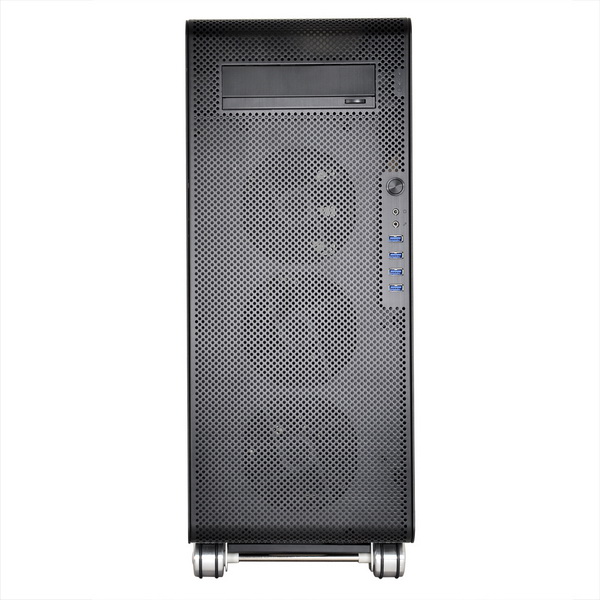 Designed for enthusiasts, the V3000 PLUS offers a great build process and improved thermal management.
Designed for enthusiasts, the V3000 PLUS offers a great build process and improved thermal management.
- fully aluminum exterior
- External mesh panel for the best air flow
- Front ARGB-lighting
- Designed logo LIAN LI
- 9000 9000 9000 9000
- Tool-free SSD installation
- Double-sided tinted tempered glass panel
- PSU swivel bracket for thicker bottom heatsink
DEFINE YOUR ROUTINE
The V3000 PLUS is designed with flexibility and capability in mind. With a removable motherboard tray and adaptable power supply shroud, the V3000 PLUS can be installed in Mode 1 as a standard build, Mode 2 for a uniquely designed rotated motherboard, or Mode 3 as a dual system.
Standard mode
Spacious cabinet for housing large components.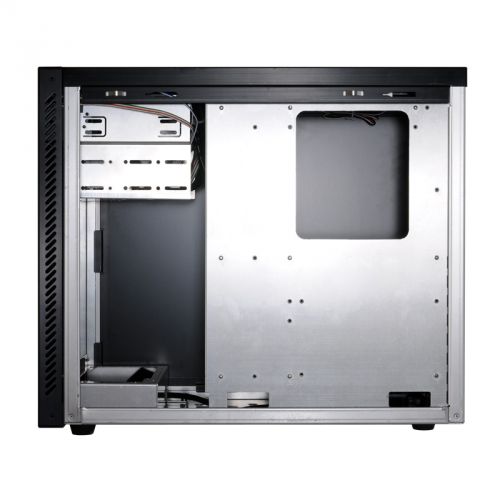
Rotated mode
GPU cooling benefits with direct airflow.
Dual system mode
Holds 2 complete systems at the same time.
SEARCHING FOR EFFICIENCY
The V3000 PLUS is designed with enthusiast-level custom water cooling in mind, using its generous space for custom cycles and endless possibilities.
Standard
rotated
Dual system
Standard
rotated
Dual system
POWERFUL POTENTIAL
D2 or DDC pumps are supplied with 5 tank mounting plates to allow customization.
Power supply cover top
Leave space for the HHD cages inside the PSU shroud.
Shrouded BP
Showcases aesthetic reservoirs in a striking chassis.
RAISE THE LIMITS
V3000 PLUS implements 1. movable drive cage (in the power supply shroud compartment or in the main chamber), 2. SSD plates (except motherboard) and 3. Toolless SSD trays -drives (behind the motherboard) for all types of storage.
SSD plates (except motherboard) and 3. Toolless SSD trays -drives (behind the motherboard) for all types of storage.
TOOL-LESS INSTALLATION
Tool-less SSD trays behind the motherboard make it easy to install SSDs.
CABLE ROUTING SPACE
For cable management, the V3000 PLUS offers 5 small Velcro straps and 2 large layered straps to create a clear routing path. In addition, the tempered glass back has a dark tint to hide the cables as much as possible.
previous
next
OPTIONAL ACCESSORIES
HOT-SWAP DRIVE MODULE
Allows you to remove and replace hard drives in the drive cage without disconnecting any cables.
RISER PCIE 4.0 GPU VERTICAL CABLE
GPU vertical mounting requires 200mm 9-angle patch cable0° to 180°.
DUAL PCIE 4.0 RISER CABLE
A 90mm 240° to 90° patch cable is required to install a 2nd GPU in the power supply shroud bay.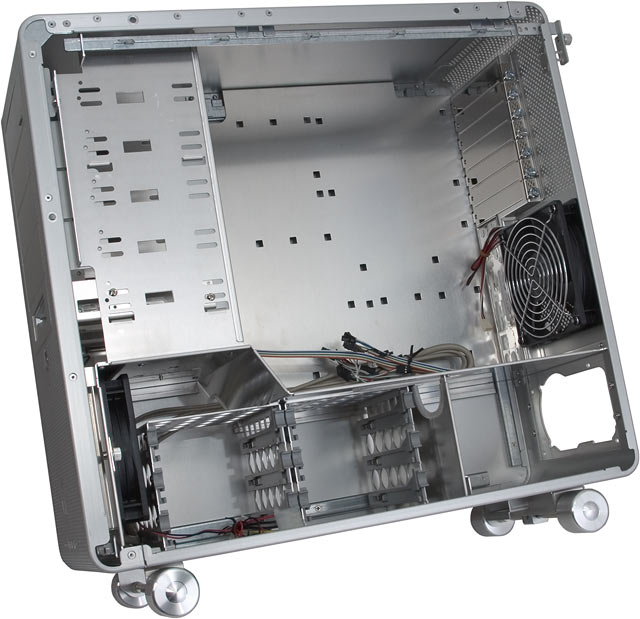
DOWNLOAD
V3000 Plus User Manual
SPECIFICATIONS
| PRODUCT NAME | LIAN LI V3000 PLUS |
|---|---|
| MODEL | V3000PX |
| DIMENSIONS | (D) 678.5 mm x (W) 279 mm x (H) 674 mm |
| COLOR | Black |
| MATERIALS | Aluminum Steel 4.0 mm dark tempered glass (right side) 4.0 mm thick tinted tempered glass (left side) |
| MOTHERBOARD SUPPORT | Standard EEB/E-ATX/ATX/Micro-ATX/Mini-ITX Rotated EEB/E-ATX/ATX/Micro-ATX/Mini-ITX Dual System System 1 /E-ATX/ATX/Micro-ATX/Mini-ITX System 2 — Mini-ITX |
| FAN SUPPORT | Standard Front: 4 x 120 mm or 3 x 140 mm Top: 4 x 120 mm or 3 x 140 mm or 2 x 200 mm Above power supply bay: 3 x 120 mm or 3 x 140 mm Bottom side: 4 x 120 mm or 3 x 140 mm Rear: 1 x 120 mm or 1 x 140 mm rotated Front: 4 x 120 mm or 3 x 140 mm Top: 4 x 120 mm or 3 x 140 mm or 2 x 200 mm Bottom: 4 x 120 mm or 3 x 140 mm Back: 3 x 120 mm or 2 x 140 mm Above power supply bay: 1 x 120 mm or 1 x 140 mm Dual system Front: 4 x 120 mm or 3 x 140 mm Top: 4 x 120 mm or 3 x 140 mm or 2 x 200 mm Above power supply bay: 2 x 120 mm or 2 x 140 mm Bottom: 4 x 120 mm or 3 x 140 mm (without System 2 GPU) Rear: 1 x 120 mm or 1 x 140 mm |
| RADIATOR SUPPORT | Standard Front: 480 mm or 420 mm Top: 480 mm or 420 mm Above power supply chamber: 360 mm or 420 mm Bottom side: 480 mm or 420 mm Rotated front or 420 mm Top: 480mm or 420mm Bottom: 480mm or 420mm Back: 360mm or 280mm Dual System Front: 480mm or 420mm Top: 480mm or 420mm Above Camera 40123 mm or 280 mm Bottom side: 480 mm or 420 mm (without System 2 GPU) |
| PSU SUPPORT | System 1 — ATX (max.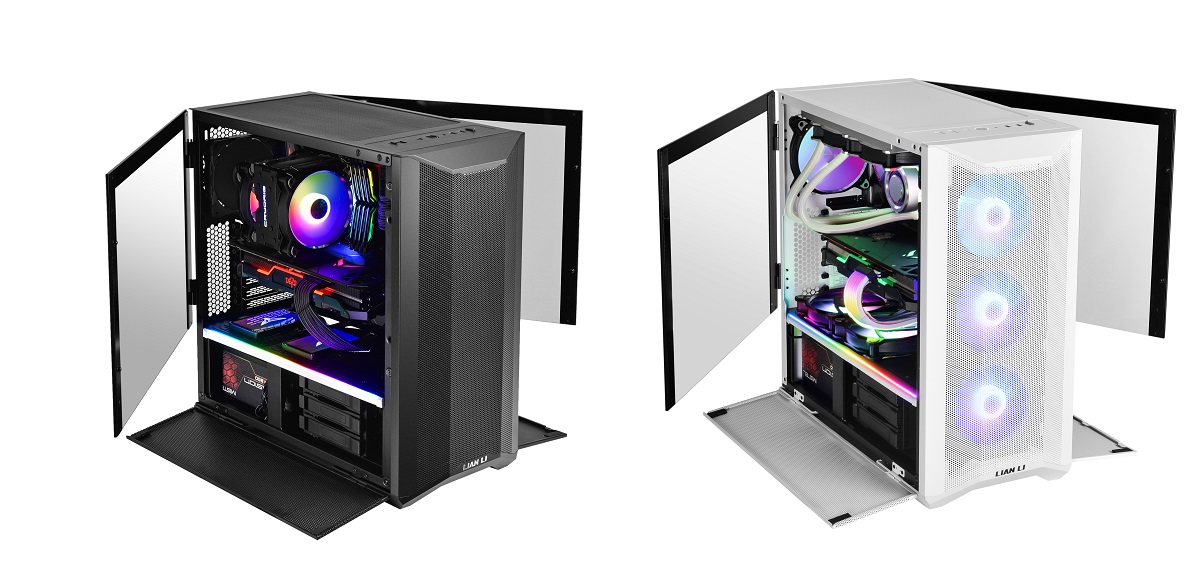 220 mm) 220 mm) System 2 — SFX-L/SFX |
| LENGTH SPACE GP | Standard Max 589mm rotated Max 358mm Double system System 1 — max. 589 mm System 2 — max. 320 mm (width max. 125 mm) |
| CPU COOLER HEIGHT | System 1 — Max 198 mm System 2 — Max 80 mm |
| DRIVE SUPPORT | Drive cage: 8 x 2.5″ SSD or 8 x 3.5″ HDD Side: 4 x 2.5″ SSD Behind MB Tray: 4 x 2.5″ SSD |
| EXPANSION SLOT | System 1 -8 System 2 — 3 (on power supply shroud, with optional vertical cable) |
| I/O PORTS | System 1 1 x Power Button 1 x Reset Button 1 Light Color Button (C) 1 Light Mode Button (M) 2 x USB 3.  0 0 1 x USB Type C 1 x Audio System 2 1 x Power Button 1 x Reset Button 2 x USB 3.0 1 x USB Type C 1 x Audio |
| DUST FILTER | 1 x bottom |
| WARRANTY | 1 year |
Page not found
Delivery options and delivery speed may vary by location.
City
BerlinAach B TrierAach, HegauAachenAalenAarbergenAasbuettelAbbenrodeAbenbergAbensbergAbentheuerAbrahamAbsbergAbstattAbtsbessingenAbtsgmuendAbtsteinachAbtswindAbtweilerAchbergAchernAchimAchslachAchstettenAchtAchtelsbachAchterwehrAchtrupAckendorfAddebuellAdelbergAdelebsenAdelheidsdorfAdelmannsfeldenAdelschlagAdelsdorfAdelsheimAdelshofen, Kr FuerstenfeldbruckAdelshofen, MittelfrAdelsriedAdelzhausenAdenauAdenbachAdenbuettelAdendorfAderstedtAdlersteigeAdligstadtAdlkofenAdmannshagen-BargeshagenAdorf/Vogtl.